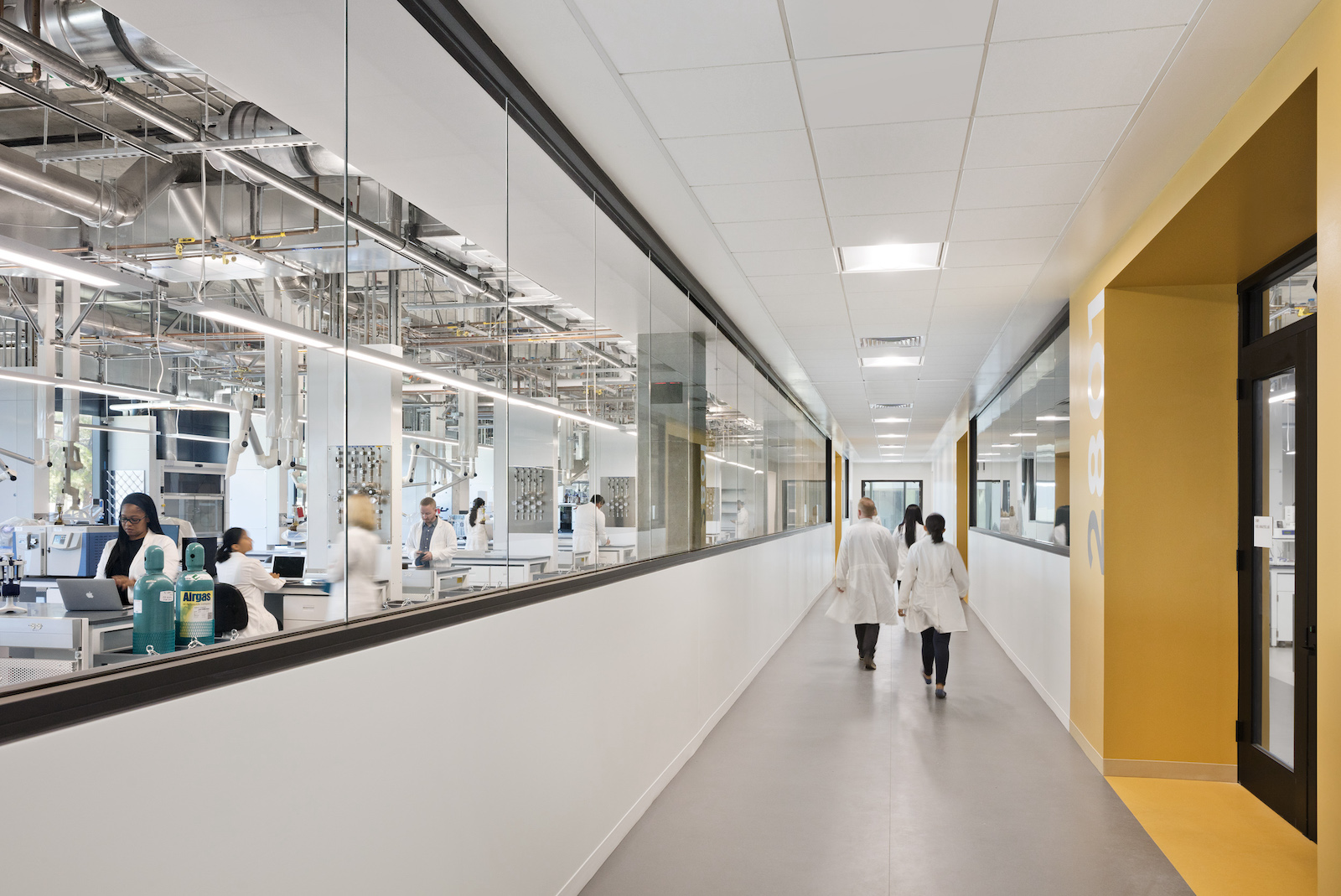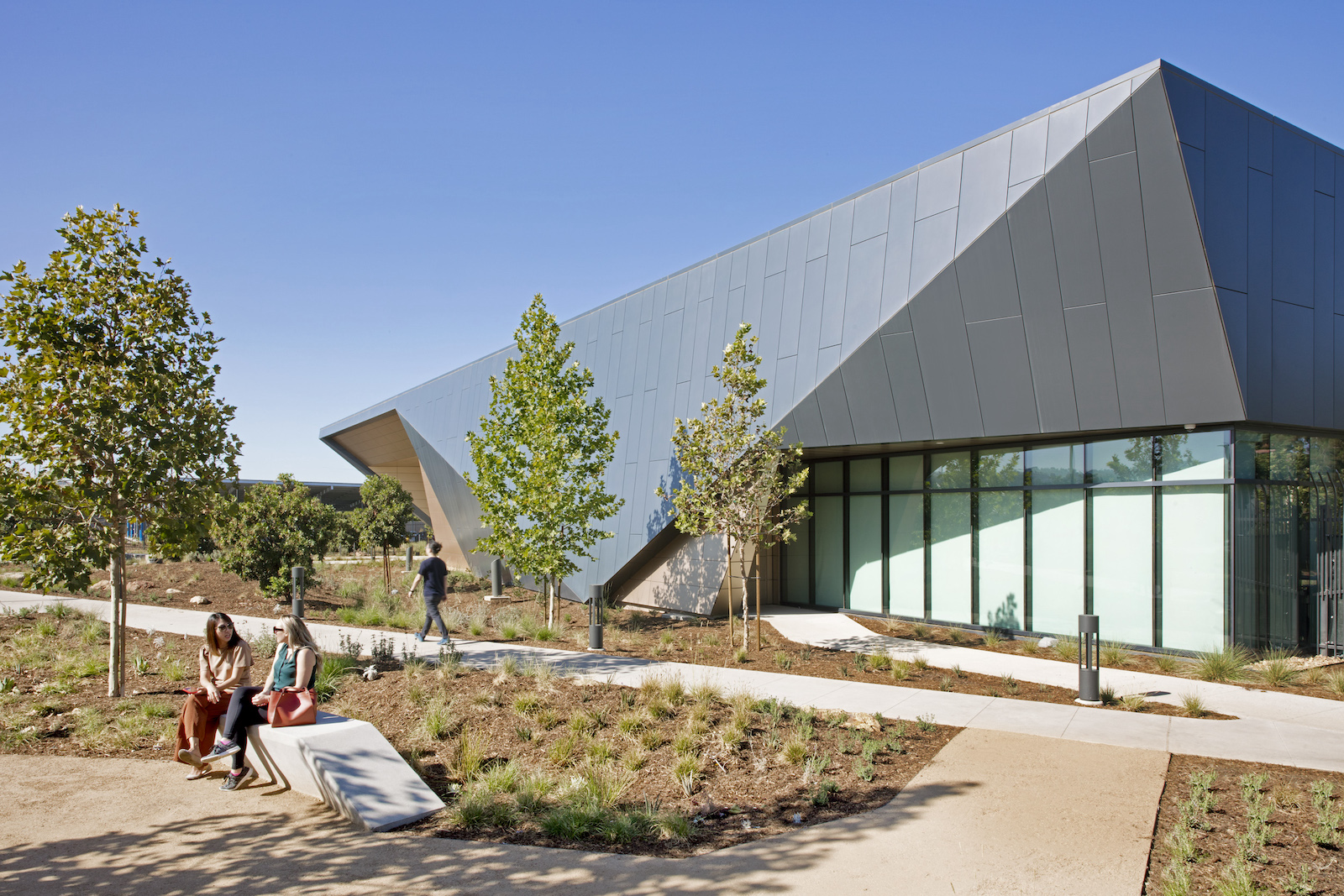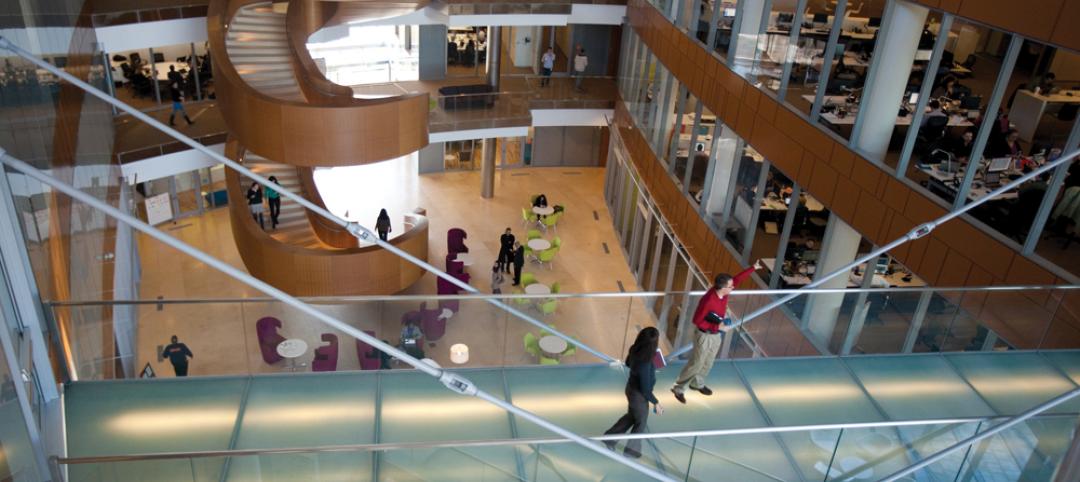The California Air Resources Board (CARB) Southern California headquarters has been completed in Riverside, Calif. The 403,306-sf is the largest vehicle emissions testing facility in the world and the largest net-zero facility of its kind.
The CARB headquarters exceeds California Title 24 requirements by 30% and lowers energy cost savings by 75%. All of the energy needed is produced onsite, making it resilient to power outages and protecting it from pausing its research operations.
CARB consolidated five existing locations across Southern California into CARB’s headquarters which improves performance and efficiency of operations while also providing a healthy workplace for the organization’s employees. The design team’s focus was not just reaching high-performance targets, but creating a quality environment for CARB’s employees.
The features of the headquarters include a complex program with myriad space types, including a main entrance and lobby, an employee entrance and lounge, a large auditorium, open office, conference room, light-and-heavy-duty vehicular emissions testing wings, specialized chemistry and hydrogen laboratories, and employee amenity spaces such as an expensive breakroom and a gym. The facility is sited on 19 acres to encourage biking, walking, public transit, and use of zero emissions vehicles to reduce transportation impacts.
The facility effectively connects users to the outdoors. The layout and form of the building establishes two principle outdoor spaces: the main courtyard to the east and a more private courtyard to the west. The building is oriented around the courtyards to lend itself to easy circulation, views, daylighting, and self-shading. Coupled with an abundance of low B VOC-emission trees and plantings, comfortable outdoor respite spaces are established for employee enjoyment.
The massing of the office building is consolidated into three stories that extend in three directions parallel to light duty testing, chemistry labs, and toward the conference buildings. This creates a smaller building footprint and shortens horizontal circulation networks, while using vertical connectivity established by a network of bridges and stairs to increase proximity between offices, testing areas, support spaces, and laboratories, resulting in increased flexibility, optimized adjacencies, and greater opportunities for intellectual collisions among employees. A variety of types and scales of meeting spaces, as well as coffee bars and cafés promote interaction and collaboration, especially for staff who circulate between the various departments throughout the day.
The ground floor of the open office atrium features testing control desks where employees conduct and operate the air regulation testing that occurs in the test cells. These inset spaces throughout the office building first floor are open and allow all users to see the AC dynamometers, among other testing equipment, in action.
Beyond putting CARB vehicular testing on display, the energy reduction strategies in the office building also largely contribute to the facility’s net-zero energy status. The integration of chilled beams allowed the atrium ceiling to be kept high, making way for the collection of skylights—a passive lighting strategy—that create expansive views of the naturally lit workspace. Paired with task lighting and daylighting harvesting, the office wing, which accounts for 41% of the total program, uses only 15% of the total energy needed to operate the building.

Energy reduction strategies include:
- Fluid cooler - Using hybrid coolers in conjunction with an elevated 570°F chilled water temperature reduced estimated energy consumption of the facility by approximately 8%.
- Aircuity and demand control ventilation - Continuous indoor air monitoring maximizes ventilation efficiency and energy reduction.
- Adiabatic humidification - Air is humidified without using steam or an additional heat source, reducing energy consumption.
- Active chilled beams - The hydronic air cooling system uses less air, reducing energy requirements and overall operating costs.
- Daylighting - Skylights increase interior daylighting. Motorized interior shades reduce glare.
- Lighting - Site lighting: high efficiency LED site in parking. Interior lighting: interiors incorporate all LED lighting, task-ambient lighting, daylight harvesting control, dual lighting / HVAC occupancy sensors.
- Electrical vehicle charging - 118 EV charging stalls provided on site with the ability to expand to a total of 149 EV parking stalls.
- Fume hood occupancy-based control - Occupancy-based sensors integrated into the chemistry lab fume hoods reduce energy demands.
- Exterior louvers - Exterior louvers integrated into the southeast and west facades reduce solar heating and glare.
- High-performance glazing - Low-e insulated glazing with exterior louvers increase operational energy efficiency.
The facility was completed in August 2021. ZGF worked with Hensel Phelps and Affiliated Engineers on the project.
Related Stories
| Aug 6, 2013
CoreNet: Office space per worker shrinks to 150 sf
The average amount of space per office worker globally has dropped to 150 square feet or less, from 225 square feet in 2010, according to a recent global survey conducted by CoreNet Global.
| Jul 30, 2013
In support of workplace chatter
As the designers of collaborative work environments, architects and engineers understand how open, transparent spaces can cultivate the casual interaction and knowledge sharing that sparks innovation. Now a new study reveals another potential benefit of open workplaces: social interaction that supports happier employees.
| Jul 29, 2013
2013 Giants 300 Report
The editors of Building Design+Construction magazine present the findings of the annual Giants 300 Report, which ranks the leading firms in the AEC industry.
| Jul 26, 2013
How biomimicry inspired the design of the San Francisco Museum at the Mint
When the city was founded in the 19th century, the San Francisco Bay’s edge and marshland area were just a few hundred feet from where the historic Old Mint building sits today. HOK's design team suggested a design idea that incorporates lessons from the local biome while creating new ways to collect and store water.
| Jul 22, 2013
Top Office Sector Construction Firms [2013 Giants 300 Report]
Turner, Structure Tone, PCL top Building Design+Construction's 2013 ranking of the largest office sector contractors and construction management firms in the U.S.
| Jul 22, 2013
Top Office Sector Engineering Firms [2013 Giants 300 Report]
AECOM, Parsons Brinckerhoff, Jacobs top Building Design+Construction's 2013 ranking of the largest office sector engineering and engineering/architecture firms in the U.S.
| Jul 22, 2013
Top Office Sector Architecture Firms [2013 Giants 300 Report]
Gensler, HOK, Perkins+Will top Building Design+Construction's 2013 ranking of the largest office sector architecture and architecture/engineering firms in the U.S.
| Jul 19, 2013
Reconstruction Sector Construction Firms [2013 Giants 300 Report]
Structure Tone, DPR, Gilbane top Building Design+Construction's 2013 ranking of the largest reconstruction contractor and construction management firms in the U.S.
| Jul 19, 2013
Reconstruction Sector Engineering Firms [2013 Giants 300 Report]
URS, STV, Wiss Janney Elstner top Building Design+Construction's 2013 ranking of the largest reconstruction engineering and engineering/architecture firms in the U.S.
| Jul 19, 2013
Reconstruction Sector Architecture Firms [2013 Giants 300 Report]
Stantec, HOK, HDR top Building Design+Construction's 2013 ranking of the largest reconstruction architecture and architecture/engineering firms in the U.S.












